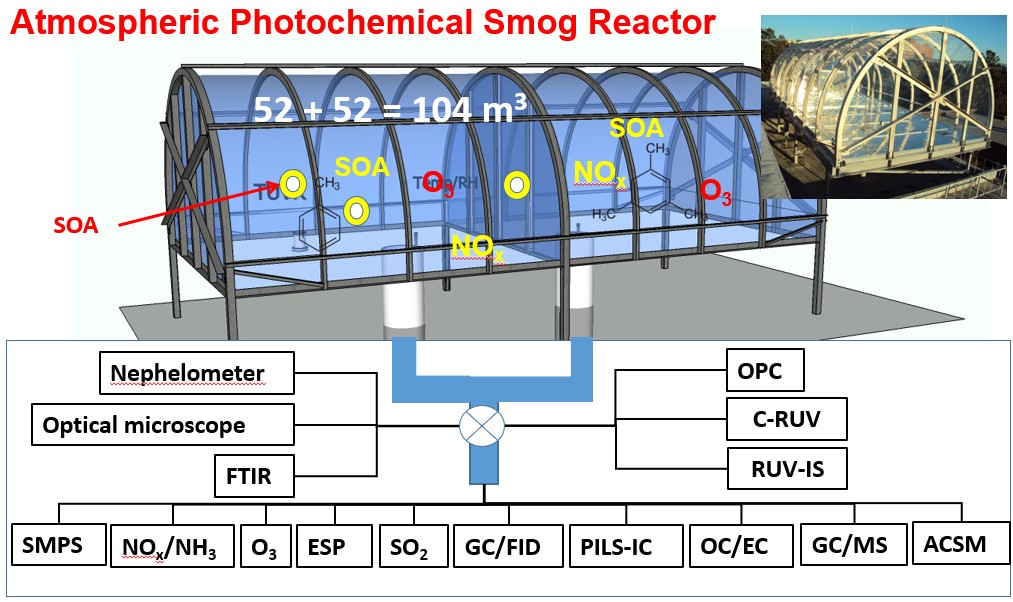The speakers for this week's seminar are:
11:55am - 12:20pm: Dr. Myoseon Jang (Invited speaker - UF): Emerging issues on Atmospheric Aerosol: Modelling, characterization, and its Implications to Health and Climate
12:20pm - 12:45pm: Dr. Xin Tang (Invited speaker - UF): new tools for the application in the systematic investigation of uni- and multi-cellular systems to understand how mechanical force and bioelectrical signals link the form and function of living systems
1) Abstract:  Airborne Particulate Matter (PM) contains microscopic solids or liquid droplets that can be inhaled and cause adverse health problems. In addition, fine PM reduces visibility in parts of the United State and impacts on climate by scattering sunlight and acting as cloud condensation nuclei that modulate cloud formation and precipitation. In this seminar, an overview of recent laboratory and modelling studies for the formation of atmospheric organic aerosol (OA) is presented. Current air quality models (AQMs) implemented in US were originally developed to predict ozone at extreme pollution episodes in urban areas. Because chemical mechanisms did not initially consider secondary organic aerosol (SOA), an important component of PM2.5, or hazardous air pollutants, AQMs use highly empirical SOA parameterizations that have been added on top of gas-phase mechanisms by using semivolatile surrogate species for which the reactions and chemical identities are disconnected from those of gas mechanisms as well as inorganic aerosol species. The chamber facility, among four worldwide, is used to simulate atmospheric photochemical aging of volatile hydrocarbons and combustion smoke, SOA formation, aerosol climate forcing and PM adverse health effects. The chamber studies of the UF research team improve the prediction of aerosol formation by characterizing air pollutants and discovering atmospheric processes of air pollutants under varying environments. Based on our chamber studies and modeling of organic aerosol formation, the following topics are addressed: 1) major hydrocarbons to form SOA in urbane atmospheres; 2) aerosol chemistry of organic species in inorganic aerosol (i.e., sulfate aerosol, seal spray aerosol, and mineral dust particles); 3) health effects; 4) the development of a new aerosol module that couples explicit gas mechanisms with emerging aerosol chemistry. Lab data related to gas mechanisms, characterization, and SOA production are lacking for hydrocarbons associated with human activities (paintings, printing inks, adhesives, cleaning reagents, and personal care products). In future, the model should expand SOA prediction to various hydrocarbons emerging as an important petrochemical source of urban organic emissions and heterogeneous chemistry of various organic species in the presence of different inorganic aerosol. Additionally, AQMs need to span a wide range of concentrations, hydrocarbons-to-NOx ratios, and temperatures to cover urban, rural, and remote environments for warm and cold seasons.
Airborne Particulate Matter (PM) contains microscopic solids or liquid droplets that can be inhaled and cause adverse health problems. In addition, fine PM reduces visibility in parts of the United State and impacts on climate by scattering sunlight and acting as cloud condensation nuclei that modulate cloud formation and precipitation. In this seminar, an overview of recent laboratory and modelling studies for the formation of atmospheric organic aerosol (OA) is presented. Current air quality models (AQMs) implemented in US were originally developed to predict ozone at extreme pollution episodes in urban areas. Because chemical mechanisms did not initially consider secondary organic aerosol (SOA), an important component of PM2.5, or hazardous air pollutants, AQMs use highly empirical SOA parameterizations that have been added on top of gas-phase mechanisms by using semivolatile surrogate species for which the reactions and chemical identities are disconnected from those of gas mechanisms as well as inorganic aerosol species. The chamber facility, among four worldwide, is used to simulate atmospheric photochemical aging of volatile hydrocarbons and combustion smoke, SOA formation, aerosol climate forcing and PM adverse health effects. The chamber studies of the UF research team improve the prediction of aerosol formation by characterizing air pollutants and discovering atmospheric processes of air pollutants under varying environments. Based on our chamber studies and modeling of organic aerosol formation, the following topics are addressed: 1) major hydrocarbons to form SOA in urbane atmospheres; 2) aerosol chemistry of organic species in inorganic aerosol (i.e., sulfate aerosol, seal spray aerosol, and mineral dust particles); 3) health effects; 4) the development of a new aerosol module that couples explicit gas mechanisms with emerging aerosol chemistry. Lab data related to gas mechanisms, characterization, and SOA production are lacking for hydrocarbons associated with human activities (paintings, printing inks, adhesives, cleaning reagents, and personal care products). In future, the model should expand SOA prediction to various hydrocarbons emerging as an important petrochemical source of urban organic emissions and heterogeneous chemistry of various organic species in the presence of different inorganic aerosol. Additionally, AQMs need to span a wide range of concentrations, hydrocarbons-to-NOx ratios, and temperatures to cover urban, rural, and remote environments for warm and cold seasons.
2) Abstract: The current focus of Tang’s Integrative Mechanobiology Laboratory is on biomechanics, unconventional mechano-electrophysiology, and in vivo/vitro functional imaging. In this IMG seminar, Tang will introduce a few new tools developed by him and his colleagues, and the application in the systematic investigation of uni- and multi-cellular systems. Tang and his colleagues aim to obtain a quantitative understanding of how mechanical force and bioelectrical signals link the form and function of living systems.


